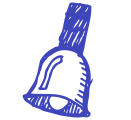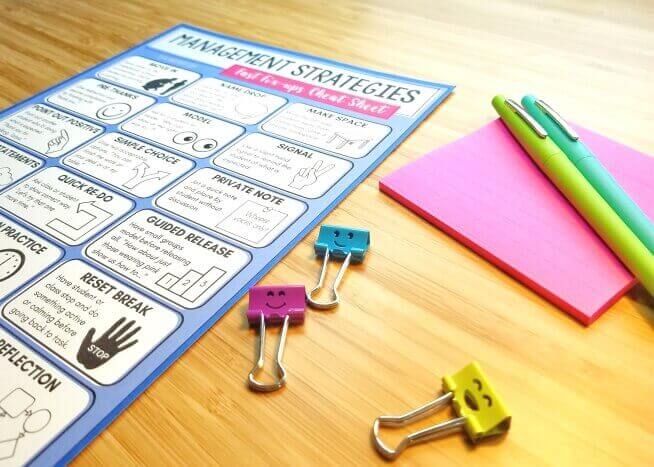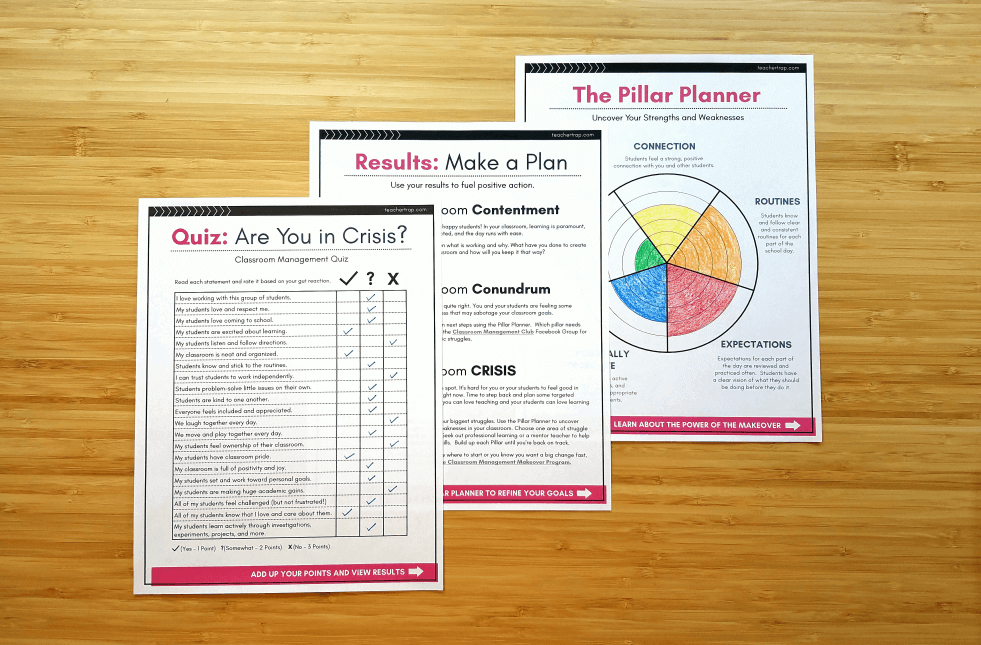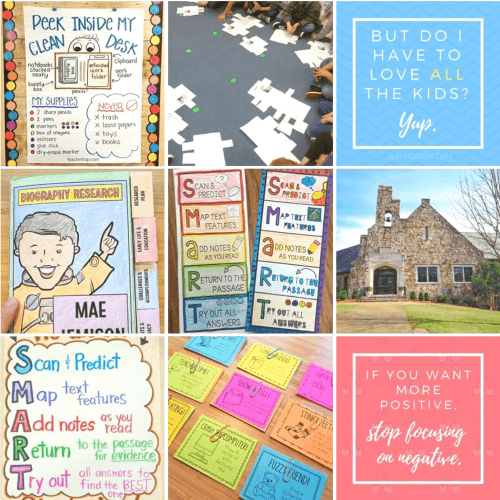When some people think of classroom management, they picture clip-charts, reward points, or behavior marks. They envision a list of rules or a system of punishments and rewards used to keep kids in line. But teachers with well-run classrooms know better.
The Pillars of Classroom Management
In this post, I’ll share The 5 Pillars of Classroom Management. These 5 key components are the secret sauce of any well-run classroom and serve as the foundation of The Classroom Management Makeover Program.
These are the make-it or break-it must-haves. If you’re struggling to create the thriving classroom of your dreams, start here. Plus, take the Classroom Management Quiz at the end to see where you stand now and what you can do next.

1. Connection
The first pillar of classroom management is CONNECTION. Students who feel connected to you and to other students behave BETTER. Imagine yourself in any new setting or group of people. How do you feel before you’ve made any connections? Unsure, anxious, maybe even distrustful? Some children come into our rooms carrying past negative experiences with adults or peers that color the way they relate to us and their new classmates.
We need to make personal connections to help those students feel seen, included, and part of our group. Only then can the walls come down. Kids who feel connected are more willing to open up and be a part of the group. They are more invested in the group’s goals and willing to hear feedback from the teacher or their peers. For some students, connection is the single most important factor in promoting better behavior.
2. Routines
Humans are creatures of habit. For much of our day, we operate on autopilot, doing things simply because it’s the way we’ve always done them. Many challenging classroom behaviors are nothing more than bad habits that can be REPLACED. By creating efficient routines and training your students to follow those routines, you are building good habits that will run on auto-pilot, too!
The beauty of strong routines is that with minimal time and maintenance, you can instill good habits that will carry on throughout the school year (and beyond). On the flip side, without strong routines, you increase feelings of anxiety and stress in your students, which in turn leads to more behavior issues.
3. Expectations
In addition to strong routines, we must repeatedly review positive and clear explanations of what we expect students to do. We often assume that kids know what we want or expect to see. Or we give expectations that tell students what NOT to do (don’t run, don’t talk, don’t hit) when our true goal is to allow students to visualize what they SHOULD be doing.
You can empower your students to come up with expectations for different parts of the school day by asking simple questions like: What should we be doing? What should it look and sound like? and, WHY? Children need opportunities to understand and practice expectations along with knowing the reasoning behind each one. This is not about posting a list of rules, but about helping kids visualize what success will look like before each activity or part of the school day.
4. Engagement
Many teachers think of engagement as a goal related to instruction and learning. But engagement may also be the single most powerful classroom management strategy available to us. When students WANT to be a part of things, when they are excited about what they are doing and are interested in the outcomes, we see better behavior.
When kids are bored, they are more easily distracted, prone to off-task behaviors, and free to cause the management issues we dread. Students who are engaged and excited about learning are motivated to make better choices that keep them involved and help them remain a part of the group.
5. Developmental Alignment
So often, we forget that kids are kids. We do things in classrooms that set our students up for frustration, boredom, anxiety, or failure. In well-run classrooms, the day is designed for the students (not the teacher). This means that we are thoughtful about the age, developmental-levels, and abilities of our students. It means that we use active learning strategies and build in times for movement and brain breaks. And it means that we differentiate instruction so that we honor the needs of different students.
For many kids, it’s frustration or boredom that leads to behavior issues in the classroom. If we want to see better behavior, we have to start setting our kids up for success by creating a learning environment that works for all of our students.
Take the Quiz
The 2-minute Classroom Management Quiz was designed to help you gauge how things are going in your classroom right now. After viewing your results, use The Pillar Planner to uncover your own strengths and weaknesses and then create a plan of action!
Next Steps
The Quiz and Planner are a great way to start noticing the gaps in your own classroom management so that you can make a plan to build up the weaker pillars. With all 5 pillars in place, your classroom will be a well-run, thriving learning community with a happy teacher and empowered students!











I thought those 5 were very important. Great article.
Thank you, Susan! I find that when these 5 things are in place, classroom management issues practically disappear!